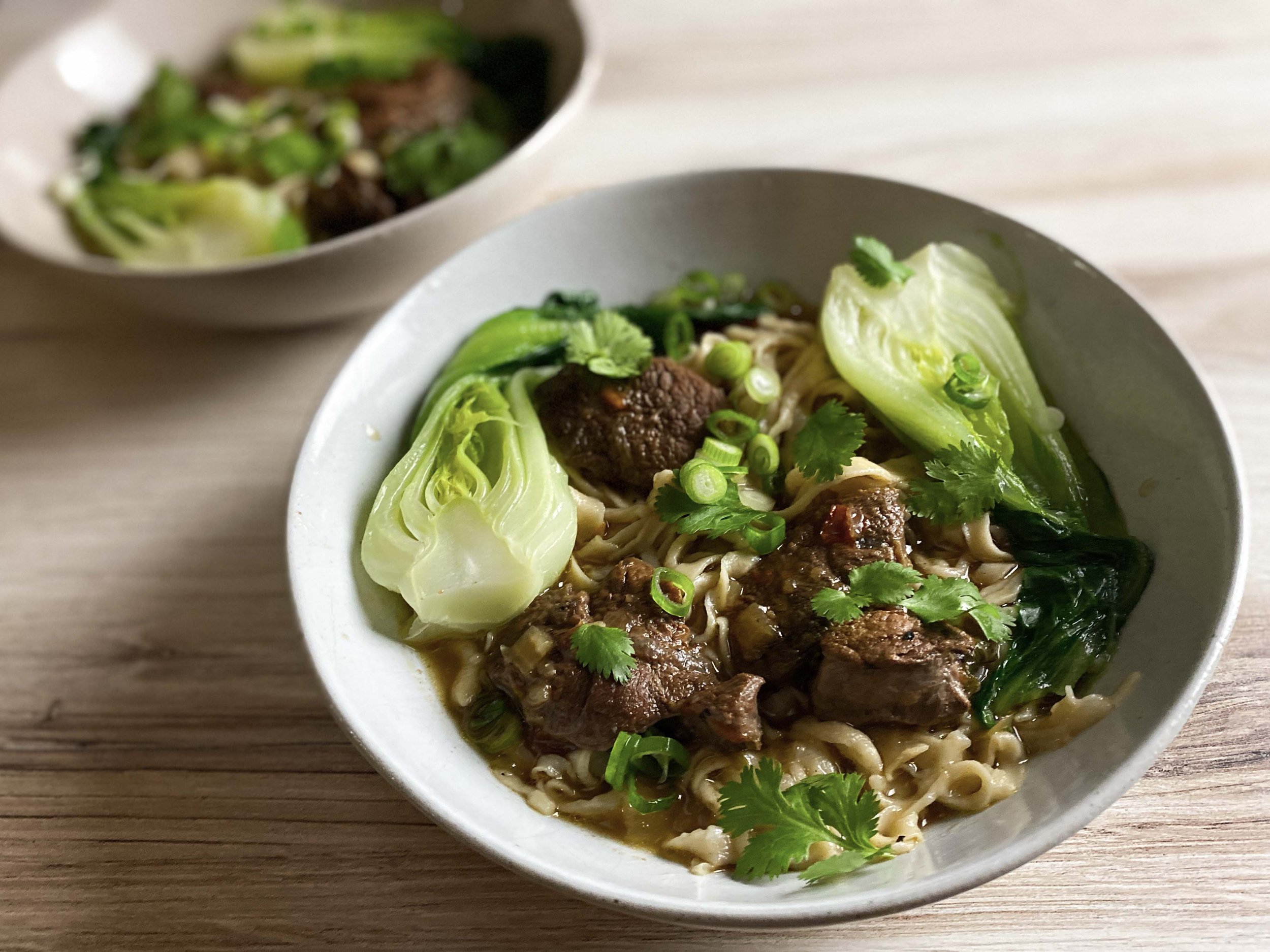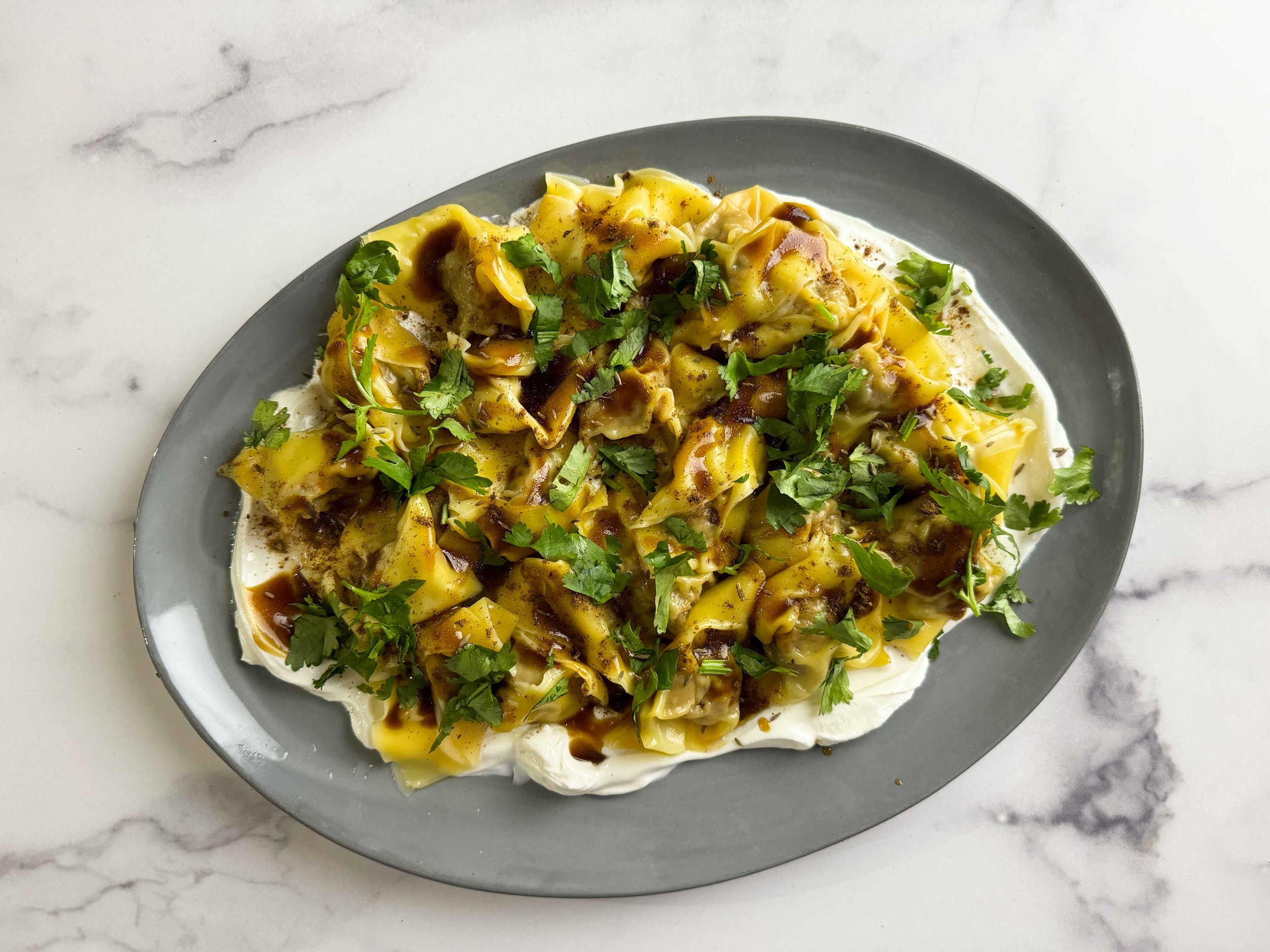Taiwanese beef noodle soup prepared from a recipe in‘First Generation: Recipes from My Taiwanese-American Home’ by Frankie Gaw
By Leslie Brenner
A Taiwanese American identity movement is gathering strength in the United States. For those of us who love to cook and want to learn about Taiwan’s culinary culture — and for Taiwanese Americans keen to celebrate and cook the dishes of their beloved island nation — three recent cookbooks provide a delicious way in.
Each is appealing in its own way. Each also brings something uniquely valuable to the table. One is the perfect primer if you’re looking for Taiwanese culinary history and cultural context. Another is filled with great recipes and soulful personal takes on the Taiwanese American experience. The third shows you how to make beloved dishes from a cult-favorite Brooklyn restaurant and bakery.
‘Made in Taiwan’: Thoughtful overview, wide-ranging recipes
Many non-Taiwanese Americans’ knowledge of Taiwanese cooking is fuzzy at best. We might know that Din Tai Fung, the global chain of soup dumpling restaurants, began in Taiwan. Or that boba tea (also known as bubble tea) is iconically Taiwanese. We might even know — for instance, if we’ve ventured into a Taiwanese restaurant here and there — that beef noodle soup and scallion pancakes are Taiwanese favorites. Maybe we’ve heard of stinky tofu: Yes, that’s Taiwanese, too.
If you’re looking for a thoughtful overview that provides excellent context, background and history of Taiwanese culinary culture and all it has to offer, Made in Taiwan is the book for you. “I hope the world can see Taiwan as more than just a geopolitical chess piece or a controversial island near China with great night markets,” writes author Clarissa Wei in her introduction. She’s an accomplished Taiwanese American journalist who was born and raised in Los Angeles, and is now based in Taiwan’s capital, Taipei. She adds:
“Our cuisine is a hodgepodge of cultures, colored by our indigenous tribes, influenced by Japanese colonists, inspired by American military aid and shaped by all the various waves of Chinese immigrants and refugees who have arrived and made this island their home.”
We learn in an excellent chapter on the culinary history of the island that 95% of Taiwan’s population is Han Chinese, which Wei points out is but a “vague umbrella term for people who have ancestry in China.” In the 17th century the first wave of Chinese immigrants, from Fujian in south China, brought “the love of seafood, rice and pork.” Taiwanese cooking is similar to Chinese, with food that is “fried or braised in large woks, or softened in hot and steamy bamboo baskets stacked on top of one another.” Taiwan and Fujian share a common love for “lightly seasoned food, occasionally heightened with a minimalistic trinity of ginger, garlic and scallions.” Sweet potatoes — which thrive on the island’s subtropical climate — is the dominant carb, along with rice. Because the mountainous terrain lacks wide grazing lands, pork, not beef, is the de facto protein; seafood is also important.
In 1949, when the communists (under Mao Zedong) took power in China over the nationalist government of Chiang Kai-shek, Chiang fled to Taiwan, establishing the Republic of China (R.O.C.), Taiwan’s official name. The R.O.C. and the U.S. became close allies and the U.S. pumped extensive military aid and exports to the island — including wheat. As a result, Taiwan fell in love with American food culture. America’s fried chicken inspired Taiwanese popcorn chicken; refugees from North China turned the wheat into dumplings and noodles.
The Recipes
Wei enlisted the help of Ivy Chen, a Taiwanese cooking instructor with deep knowledge of the island’s countryside culinary traditions that Wei says is lacking among “younger city folk.” The two traveled widely around the R.O.C. to gather inspiration from far-flung cooks.
Pickled Mustard and Pork Noodle Soup (Zhà Cài Ròu Sī Miàn)
This comforting noodle soup features preserved mustard stems, which you can make yourself (there’s a recipe in the book) or pick up at a well stocked Asian supermarket; there you can also look for fresh (or fresh frozen) Taiwanese wheat noodles, or use dried. Homemade pork broth makes the difference between a good soup and a great one in this case; I tried it both ways and vote for the homemade broth over purchased chicken broth.
RECIPE: Pickled Mustard and Pork Noodle Soup (Zha Cai Rou Si Mian)
I also enjoyed making Braised Napa Cabbage with shiitake, wood-ear mushrooms and carrots; with steamed or brown rice, it makes a lovely plant-forward dinner; and I’m eager to make Sweet Potato Leaves Stir-Fry, once I can get my hands on sweet potato leaves. A Quick Seafood Congee looks wonderful, and so does Smoked Betel Leaf Pork Sausage — though I don’t know if I’m up to wrangling hog casings. Made in Taiwan’s recipe for Three-Cup Chicken was satisfying, but the sauce didn’t work properly; it wouldn’t reduced to the “treacly, sticky glaze” the recipe promises and the famous dish is known for.
Pickled Mustard Greens, on the other hand worked great. Once I sun-dry them and age them, I can use them next time I make the Pickled Mustard and Pork Noodle Soup.
Made in Taiwan: Recipes and Stories from the Island Nation by Clarissa Wei with Ivy Chen, Simon Element, $40.
‘First Generation’: Storytelling with a giant heart, and recipes that work
If you want to gain a sense of what it’s like growing up in a Taiwanese American family, Frankie Gaw’s debut book (published in late 2022) has your name on it. You’ll eat super well along the way.
I fell hard for Gaw, the cook behind the delightful Little Fat Boy blog; His headnotes are some of the most engaging I’ve ever read. Here’s how he introduces his Grandma’s Pearl Meatballs:
“This was one of the very first recipes my grandma taught me when I started learning to cook fro her. I had never even seen it before she taught me. I remember following her lead as she combined a familiar mixture of pork, ginger and scallions into a meatball, then rolled it in grains of sweet glutinous rice that looked like pearls. After an 18-minute steam, lifting the steamer lid revealed glistening sticky rice balls, every grain soaked with pork juice and the aroma of bamboo. I can trace this recipe back to the Hubei province of China; it’s one of the dishes that makes me proud to be Asian.”
Who could resist?!
RECIPE: Frankie Gaw’s Grandma’s Pearl Meatballs
Gaw’s recipes are a pure pleasure to make — they’re as much about having fun with the process as they are with the end result. Excellent step-by-step visuals (expertly illustrated and photographed by Gaw himself) show how to pull noodles, wrap wontons, make braided bao wrappers and more.
Dan Bing
When Gaw writes that the egg crepes known as Dan Bing are a traditional Taiwanese breakfast dish his grandma used to make for him — and the simplest dish in the entire book — of course I had to make that, too. I loved them.
RECIPE: Dan Bing
And here’s his recipe for his Uncle Jerry’s Taiwanese Beef Noodle Soup, shown at the top of this review:
RECIPE: Frankie Gaw’s Uncle Jerry’s Taiwanese Beef Noodle Soup
Meanwhile, smack in the middle of the book, Gaw includes a full-page coming-out letter to his dad. It’s adorable, funny, poignant and brave — and followed by a recipe for Scallion Pancakes, whose headnote literally made me cry. Don’t ask why; just buy the book and read it all.
FIRST GENERATION; RECIPES FROM MY TAIWANESE-AMERICAN HOME BY FRANKIE GAW, TEN SPEED PRESS, 2022 $32.50.
‘Win Son Presents a Taiwanese American Cookbook’: Razzle-dazzle from a Brooklyn hot spot
This book from Josh Ku and Trigg Brown, the founders of Brooklyn’s Win Son and Win Son Bakery, (with an assist from writer Cathy Erway) is pure, exuberant fun — the kind of fun that one imagines makes the restaurant and bakery such hot tickets.
What sets it apart from First Generation and Made in Taiwan is that the recipes explode with creativity, and they don’t shy away from embracing wild fusions.
Lamb Wontons
Case in point: a platter of gingery, garlicky lamb wontons set on a schmear of labneh (yes, labneh!), dusted with cumin seeds, then sprinkled with a special “lamb spice mix,” drizzled with sweet soy dipping sauce and chile oil and showered with cilantro leaves. Weird-sounding? Maybe. Over the top? Definitely. Delicious? Absolutely.
RECIPE: Win Son’s Lamb Wontons
Win Son’s recipes are very cheffy, and not always in a user-friendly way. There are lots of sub-recipes, and in amounts that don’t make sense for a home cook. (What are you going to do with 2/3 cup of leftover lamb spice mix? Our adapted recipe adjusts so you only make enough for the wontons.) Yields are sometimes off. (The wonton recipe says it makes about 35; we had enough filling for 65.)
And sometimes the recipes just don’t behave. When I made Sun Cookies — a bakery signature — I took the authors’ suggested shortcut, using purchased frozen puff pastry instead of spending hours making a rough-puff pastry. Coming out of the oven, the cookies seemed to be complete flops, with lots of (very expensive!) pine nuts and caramelly filling spilling out of them as they baked. They looked nothing like the photo in the book. I nearly threw them away.
A sheet pan of Sun Cookies, their filling half-leaked out and looking strange, next to a photo of the cookie from the book
But once they cooled, I flipped them over, and hey! — they looked much like the ones in the book. That filling was almost painfully sweet, but the cookies were kind of evilly good — though I’m guessing the ones from the bakery starring freshly made rough puff are a thousand times better.
The Sun Cookies, once I flipped them over
These are the kinds of problems that are typical for chef books — which is why it’s so important the recipes are thoroughly tested before publication, along with careful editing and copy editing. Alas, these important steps are falling more and more by the wayside.
That said, Win Son Presents has an awful lot of charm, especially for fans of the restaurant and bakery. If you’re going to buy the book and attempt the recipes, best if you’re a more experienced cook, so you can spot any potential problems before getting too far into them. (Fear not — our adapted recipes fix all such rough spots.) If you are a confident chef who can adapt when things don’t go as anticipated, there’s plenty of worthwhile inspiration in Win Son Presents’ pages.
Win Son’s Soybean, Tofu Skin and Pea Shoot Salad
Fortunately I had my guard up when I made the Green Soybean, Tofu Skin and Pea Shoot Salad: The recipe called for 4 ounces, or 115 grams, of roasted seaweed snacks, which you’re supposed to crush and toss with the salad. I figured it was a mistake — seaweed snacks usually come in 4-gram or 10-gram packs. One hundred fifteen grams is a comical amount, a giant bowlful that would have completely overwhelmed the salad. I used 10 grams, which was more than enough, and adjusted our adapted recipe accordingly. The salad was a winner — fresh, fun and different. (And vegan!)
RECIPE: Win Son’s Soybean, Tofu Skin and Pea Shoot Salad











